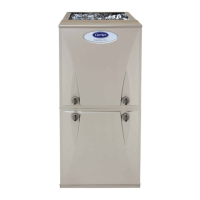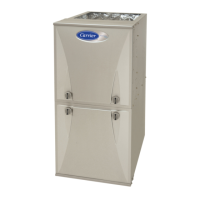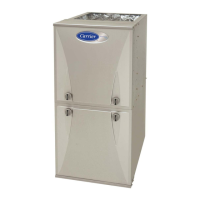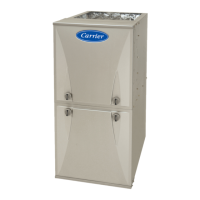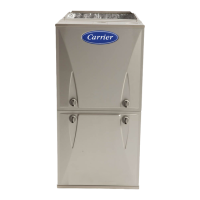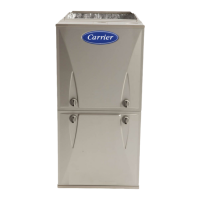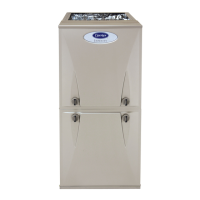SEQUENCE OF OPERATION
NOTE: Furnace control must be grounded for proper operation or
else control will lock out. Control is grounded through
green/yellow wire routed to gas valve and burner box screw. Using
the schematic diagram in Fig. 64, follow the sequence of operation
through the different modes. Read and follow the wiring diagram
very carefully.
NOTE: If a power interruption occurs during a call for heat
(W/Wl or W/Wl-and-W2), the control will start a 90-sec
blower-only ON period two sec after power is restored, if the
thermostat is still calling for gas heating. The amber LED light will
flash code 12 during the 90-sec period, after which the LED will
be ON continuous, as long as no faults are detected. After the
90-sec period, the furnace will respond to the thermostat normally.
The blower door must be installed for power to be conducted
through the blower door interlock switch ILK to the furnace
control CPU, transformer TRAN, inducer motor IDM, blower
motor BLWM, hot-surface igniter HSI, and gas valve GV.
1. Two-Stage Heating (Adaptive Mode) with Single-Stage
Thermostat
See Fig. 35 and 36 for thermostat connections
NOTE: The low-heat only switch SWI-2 selects either the
low-heat only operation mode when ON, (see item 2. below) or
the adaptive heating mode when OFF in response to a call for heat.
(See Fig. 55.) When the W2 thermostat terminal is energized it will
always cause high-heat operation when the R-to-W circuit is
closed, regardless of the setting of the low-heat only switch. This
furnace can operate as a two-stage furnace with a single-stage
thermostat because the furnace control CPU includes a
programmed adaptive sequence of controlled operation, which
selects low-heat or high-heat operation. This selection is based
upon the stored history of the length of previous gas-heating
periods of the single-stage thermostat.
The furnace will start up in either low- or high-heat. If the furnace
starts up in low-heat, the control CPU determines the low-heat
on-time (from 0 to 16 minutes) which is permitted before
switching to high-heat.
If the power is interrupted, the stored history is erased and the
control CPU will select low-heat for up to 16 minutes and then
switch to high-heat, as long as the thermostat continues to call for
heat. Subsequent selection is based on stored history of the
thermostat cycle times.
The wall thermostat "calls for heat", closing the R-to-W circuit.
The furnace control performs a self-check, verifies the low-heat
and high-heat pressure switch contacts LPS and HPS are open, and
starts the inducer motor IDM in high-speed.
a. Inducer Prepurge Period
(1.) If the furnace control CPU selects low-heat opera-
tion the inducer motor IDM comes up to speed, the
low-heat pressure switch LPS closes, and the fur-
nace control CPU begins a 15-sec prepurge period.
If the low-heat pressure switch LPS fails to remain
closed the inducer motor IDM will remain running
at high-speed. After the low-heat pressure switch
re-closes the furnace control CPU will begin a
15-sec prepurge period, and continue to run the
inducer motor IDM at high-speed.
(20 If the furnace control CPU selects high-heat opera-
tion, the inducer motor IDM remains running at
high-speed, and the high-heat pressure switch re-
lay HPSR is de-energized to close the NC contact.
When sufficient pressure is available the high-heat
pressure switch HPS closes, and the high-heat gas
valve solenoid GV-HI is energized. The furnace
control CPU begins a 15-sec prepurge period after
the low-heat pressure switch LPS closes. If the
81
high-heat pressure switch HPS fails to close and
the low-heat pressure switch LPS closes, the fur-
nace will operate at low-heat gas flow rate until the
high-heat pressure switch closes for a maximum of
2 minutes after ignition.
b. Igniter Warm-Up -At the end of the prepurge period, the
Hot-Surface Igniter HSI is energized for a 17-sec igniter
warm-up period.
c. Trial-For-Ignition Sequence -When the igniter warm-
up period is completed the main gas valve relay contact
GVR closes to energize the gas valve solenoid GV-M. The
gas valve solenoid GV-M permits gas flow to the burners
where it is ignited by the HSI. Five sec after the GVR
closes, a 2-sec flame proving period begins. The HSI ig-
niter will remain energized until the flame is sensed or until
the 2-sec flame proving period begins. If the furnace con-
trol CPU selects high-heat operation, the high-heat gas
valve solenoid GV-HI is also energized.
d. Flame-Proving - When the burner flame is proved at the
flame-proving sensor electrode FSE, the inducer motor
IDM switches to low-speed unless the furnace is operating
in high-heat, and the furnace control CPU begins the
blower-ON delay period and continues to hold the gas
valve GV-M open. If the burner flame is not proved within
two sec, the control CPU will close the gas valve GV-M,
and the control CPU will repeat the ignition sequence for
up to three more Trials-For-Ignition before going to Igni-
tion-Lockout. Lockout will be reset automatically after
three hours, or by momentarily interrupting 115 v ac power
to the furnace, or by interrupting 24 vac power at SECI or
SEC2 to the furnace control CPU (not at W/WI, G, R, etc.).
If flame is proved when flame should not be present, the
furnace control CPU will lock out of Gas-Heating mode
and operate the inducer motor IDM on high speed until
flame is no longer proved.
e. Blower-On delay - If the burner flame is proven the
blower-ON delays for low-heat and high-heat are as fol-
lows:
Low-heat - 45 sec after the gas valve GV-M is opened
the blower motor BLWM is turned ON at low-heat airflow.
High-heat - 25 sec after the gas valve GV-M is opened
the BLWM is turned ON at high-heat airflow. Simultan-
eously, the humidifier terminal HUM and electronic air
cleaner terminal EAC-1 are energized and remain ener-
gized throughout the heating cycle.
f. Switching from Low- to High-Heat - If the furnace con-
trol CPU switches from low-heat to high-heat, the furnace
control CPU will switch the inducer motor IDM speed
from low to high. The high-heat pressure switch relay
HPSR is de-energized to close the NC contact. When suffi-
cient pressure is available the high-heat pressure switch
HPS closes, and the high-heat gas valve solenoid GV-HI
is energized. The blower motor BLWM will transition to
high-heat airflow five sec after the furnace control CPU
switches from low-heat to high-heat.
g. Switching from High- to Low-Heat -The furnace con-
trol CPU will not switch from high-heat to low-heat while
the thermostat R-to-W circuit is closed when using a
single-stage thermostat.
h. Blower-OffDelay -When the thermostat is satisfied, the
R to W circuit is opened, de-energizing the gas valve GV-
M, stopping gas flow to the burners, and de-energizing the
humidifier terminal HUM. The inducer motor IDM will re-
main energized for a 15-sec post-purge period. The
blower motor BLWM and air cleaner terminal EAC- 1 will
remain energized at low-heat airflow or transition to low-
heat airflow for 90, 120, 150, or 180 sec (depending on se-
ii

